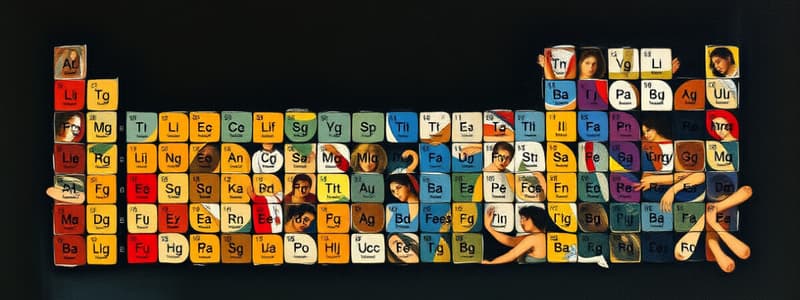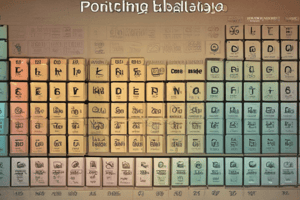Podcast
Questions and Answers
What organization principle does the periodic table primarily use to arrange elements?
What organization principle does the periodic table primarily use to arrange elements?
- Atomic number and electron configuration (correct)
- Density and mass
- Reactivity and color
- Weight and historical discovery
Which group in the periodic table contains highly reactive metals?
Which group in the periodic table contains highly reactive metals?
- Alkali Metals (Group 1) (correct)
- Noble Gases (Group 18)
- Halogens (Group 17)
- Transition Metals
In which part of the periodic table are non-metals predominantly found?
In which part of the periodic table are non-metals predominantly found?
- Left side
- Center
- Bottom
- Right side (correct)
How does atomic radius change as you move across a period in the periodic table?
How does atomic radius change as you move across a period in the periodic table?
Which group contains inert gases that do not readily react?
Which group contains inert gases that do not readily react?
What characteristic is shared by elements in the same group of the periodic table?
What characteristic is shared by elements in the same group of the periodic table?
What is the general trend of ionization energy as one moves down a group in the periodic table?
What is the general trend of ionization energy as one moves down a group in the periodic table?
What do metalloids typically exhibit?
What do metalloids typically exhibit?
Which periodic trend tends to increase across a period?
Which periodic trend tends to increase across a period?
What is the main difference between the modern and early periodic tables?
What is the main difference between the modern and early periodic tables?
Flashcards are hidden until you start studying
Study Notes
NCERT Periodic Table in Physics
-
Definition: The periodic table organizes elements based on their atomic number, electron configuration, and recurring chemical properties.
-
Structure:
- Rows: Called periods (7 in total) represent energy levels of electrons.
- Columns: Known as groups or families (18 total) share similar properties and valence electron configurations.
-
Key Features:
- Metals: Located on the left and center; good conductors, malleable, ductile.
- Non-Metals: Found on the right; poor conductors, brittle in solid form.
- Metalloids: Positioned between metals and non-metals; exhibit properties of both.
-
Important Groups:
- Alkali Metals (Group 1): Highly reactive, soft metals; e.g., Lithium, Sodium.
- Alkaline Earth Metals (Group 2): Reactive but less than alkali metals; e.g., Magnesium, Calcium.
- Halogens (Group 17): Very reactive non-metals; e.g., Fluorine, Chlorine.
- Noble Gases (Group 18): Inert gases, do not readily react; e.g., Helium, Neon.
-
Periodic Trends:
- Atomic Radius: Generally decreases across a period and increases down a group.
- Ionization Energy: Increases across a period and decreases down a group.
- Electronegativity: Tends to increase across a period and decrease down a group.
-
Applications:
- Understanding chemical behavior and reactivity.
- Predicting properties of new elements and compounds.
- Fundamental in chemistry, physics, and material science.
-
Modern Periodic Table: Based on the atomic number rather than atomic weight, reflecting advancements in understanding atomic structure.
-
Special Configurations: Transition metals and lanthanides/actinides have unique electron configurations affecting their chemical properties.
-
Visual Representation: The periodic table is often color-coded to indicate different categories of elements (metals, non-metals, etc.).
Understanding the periodic table is crucial for studying chemical reactions and properties in physics and chemistry.
Periodic Table Overview
- Organizes elements by atomic number, electron configuration, and recurring chemical properties.
- Essential for predicting and understanding chemical behavior.
Structure of the Periodic Table
- Periods: Seven horizontal rows representing energy levels of electrons.
- Groups/Families: Eighteen vertical columns sharing similar properties and valence electron configurations.
Key Features
- Metals: Found on the left and center; characterized as good conductors, malleable, and ductile.
- Non-Metals: Located on the right; generally poor conductors and brittle in solid form.
- Metalloids: Situated between metals and non-metals; display a mix of both properties.
Important Groups of Elements
- Alkali Metals (Group 1): Soft, highly reactive metals; examples include Lithium and Sodium.
- Alkaline Earth Metals (Group 2): Reactive but less so compared to alkali metals; examples are Magnesium and Calcium.
- Halogens (Group 17): Extremely reactive non-metals; include Fluorine and Chlorine.
- Noble Gases (Group 18): Inert gases that do not readily react; prominent examples are Helium and Neon.
Periodic Trends
- Atomic Radius: Decreases across a period and increases down a group; influences element size.
- Ionization Energy: Increases across a period due to stronger nuclear attraction; decreases down a group as electrons are farther from the nucleus.
- Electronegativity: Tends to increase across a period while decreasing down a group; impacts an element's ability to attract electrons.
Applications of the Periodic Table
- Essential for predicting properties and chemical behavior of elements.
- Fundamental utility in chemistry, physics, and material science.
Modern Periodic Table
- Organized based on atomic number instead of atomic weight; reflects improved understanding of atomic structure.
Special Electron Configurations
- Transition metals and lanthanides/actinides exhibit unique electron configurations, influencing their chemical properties.
Visual Representation
- The periodic table is often color-coded to differentiate between categories of elements (metals, non-metals), aiding in quick identification and study.
Studying That Suits You
Use AI to generate personalized quizzes and flashcards to suit your learning preferences.




